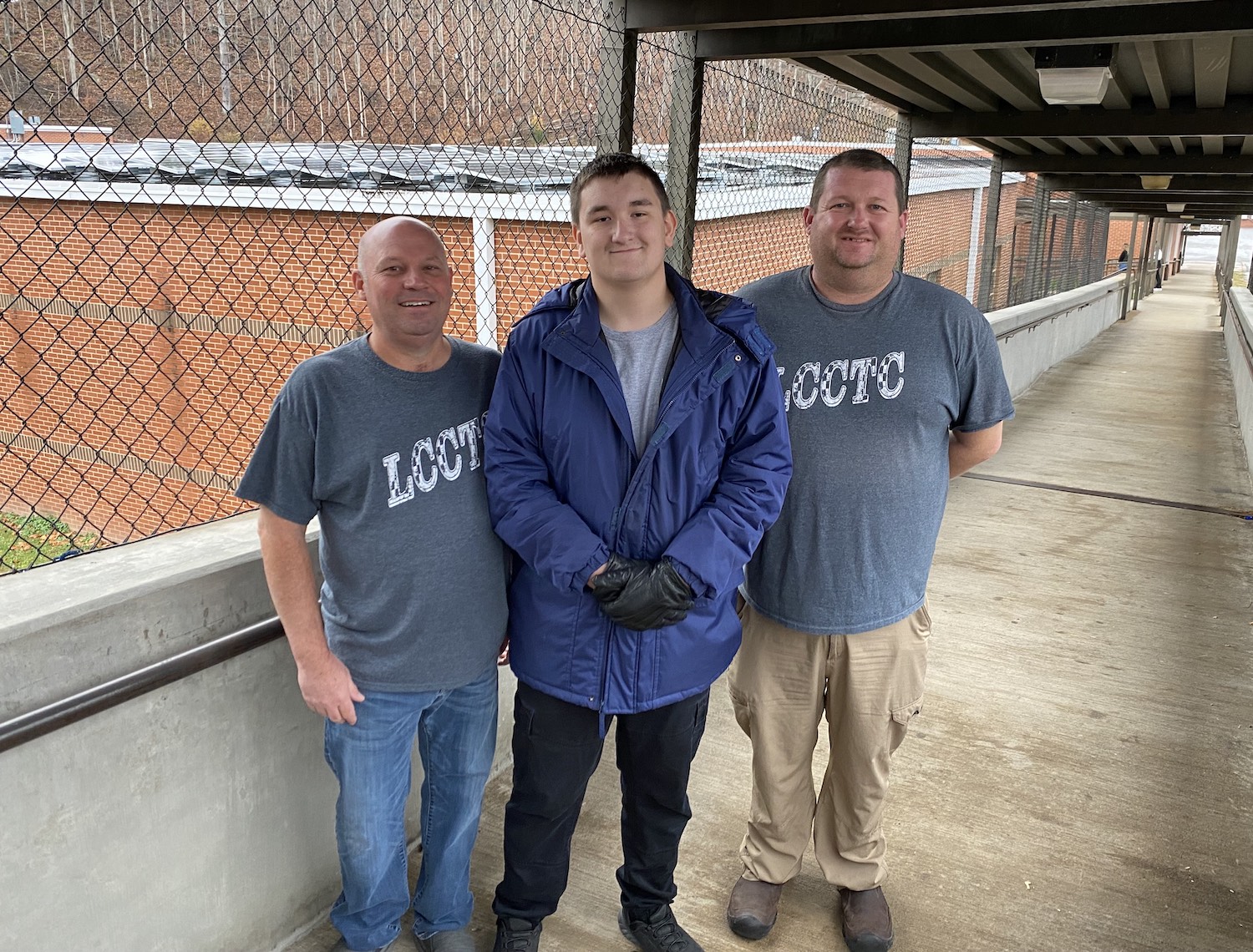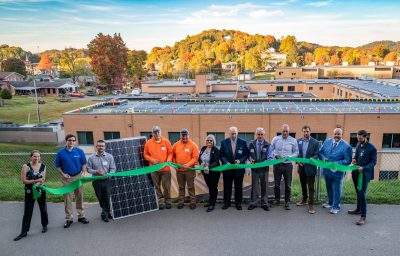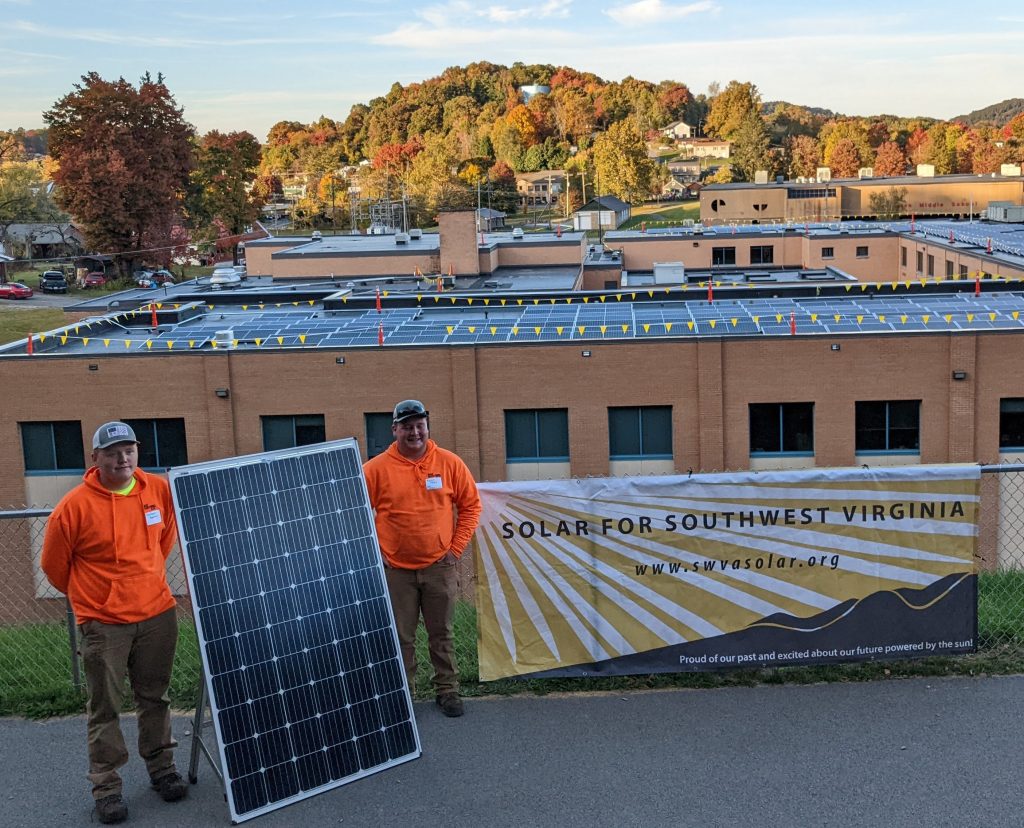Solar Apprenticeship Program Benefits Southwest Virginia

From the left, Mark Long, career and technical administrator for Lee County Public Schools, Isaac Carter, a senior at Lee County Career and Technical School, and Jonathan Mullins, an electricity teacher at the center, stand with the school’s rooftop solar array visible in the background. Carter installed similar solar systems as an apprentice in the 2023 session of the Solar Workforce Accelerator Program. Photo by Rance Garrison
By Lorelei Goff
Isaac Carter’s summer days started early. The 17-year-old from Dryden, Virginia, unloaded trailers, carried equipment up ladders to rooftops and pulled wires to connect solar panels.
It was hard but satisfying work, and it paid $17 an hour – a good wage for a young person in rural Southwest Virginia. He also earned college credit for it, has an internship experience to add to his resume and obtained an Occupational Safety and Health Administration certification, commonly known as an OSHA 10 card, that makes him more desirable to employers – all before he began his last year of high school.
Carter was part of the Solar Workforce Accelerator Program, a youth solar apprenticeship program in Southwest Virginia. The program operates as a partnership between Mountain Empire Community College, the Solar Workgroup of Southwest Virginia collaborative group, solar company Secure Solar Futures, Wise and Lee county public schools and the electric company Got Electric.
Since its start in 2022, 15 students have completed the program, logging a total of about 450 working hours to install solar arrays on four public school campuses. Two students from the 2022 cohort were hired by Got Electric and several went on to attend MECC to continue their education in related fields. From the 2023 cohort, two students plan to attend MECC for HVAC, two plan to complete MECC’s program to become lineworkers and Carter hopes to go on to work for Got Electric.
Before taking part in the program, Carter, now a senior at Lee County Career and Technical Center, didn’t know what his next step after graduation would be.
“I took the apprenticeship just to see what I would get into and I found out that, yeah, I really like to do electricity work,” says Carter. “And of course the money was always great. [The program] provided the tools, the boots and all the equipment and stuff.”
The apprenticeship began with a week-long orientation that included safety training and obtaining the required OSHA 10 card before students could work on-site. They also received training in basic photovoltaic system design and electricity. Then, they helped with the installation. Carter worked on rooftop solar arrays on Coeburn and Union primary schools and Union Middle School.
“It was a really great experience,” Carter says. “We had great guys that we were working with.”
He enjoyed what he calls hard, honest work and getting a taste of what it’s like to be part of the workforce.
“It was a pretty big confidence boost whenever I went in and actually saw that I was actually able to do the work,” says Carter, who believes the apprenticeship will help him earn more in the workforce.
He also believes the community is reaping benefits from the program, which is helping schools to save money and showing people that solar power is accessible.

Anthony Hamilton and Jason Taylor, in orange shirts, joined local, state and federal officials for the ribbon cutting to celebrate completion of a solar panel installation project on Wise Elementary School in 2022.The solar power systems installed at four elementary and middle school campuses are expected to save the school division $7.5 million over the lifetime of the solar equipment. Photo by J.M. Davidson.
The solar power systems installed at four elementary and middle school campuses are expected to save the school division $7.5 million over the lifetime of the solar equipment.
Carter hopes to work for Got Electric during the summer of 2024. He plans to use the college credit he earned to further his education at Mountain Empire Community College.
Ultimately, with the skills and confidence gained through his internship experience, Carter hopes to one day work for himself.
“It’s opened my eyes to the stuff that I’m able to do,” Carter says.
Powering opportunities
Opening students’ eyes to their potential is one reason Josh Kraybill wanted his company to take part in the apprenticeship program.
“It’s life skills opportunities for these young people,” says Kraybill, senior project manager with Got Electric. “What does it look like to make a commitment to a job and then to show up every day and go to work?
Matt Rose, the dean of industrial technology at Mountain Empire Community College, hopes the program will allow more students to remain in their rural communities. While the college offers a certificate in solar installation, students wanting to pursue a career in solar typically moved out of the area due to a lack of employment opportunities, according to Rose.
“One reason I think the partnership has been really beneficial is it helps demonstrate to students that they can get jobs in solar and they can get jobs installing solar locally in the region,” he says.
Rose believes the impact on the communities they live in may be more significant in ways beyond increasing a community’s tax base.
“Not only do you lift the economics there,” Rose says, “Just think of the vibrancy that young person brings to the community, especially as they grow and they have families.”
The partnership is also helping to accelerate the switch to green energy in the region through a bigger demand for solar installation.
Historically, to entertain the idea of solar energy in what previously was known as coal country was taboo. But with the coal industry’s decline, solar is now often seen as good sense. Solar boosters point out that solar energy lowers electricity costs, provides jobs and helps position the region to regain its vital role in energy production, while bringing a cleaner industry to a region exploited and damaged by the extractive fossil fuel industry.
According to Rose, the apprenticeship program makes that possible.
The apprenticeship program uses a business model that grows the workforce by customer demand rather than by company products. It develops the projects while creating jobs and building the workforce at the same time.
A cooperative effort
The Solar Workforce Accelerator Program and the groups involved partnered with the Appalachian Solar Finance Fund to make sure the school solar arrays could take advantage of power purchase agreements, a financing mechanism that the Virginia General Assembly allowed for K-12 public schools in areas serviced by Appalachian Power Company and Old Dominion Utility Services, Inc., in 2020.

After the Virginia General Assembly allowed power purchase agreements were allowed in K-12 schools served by Appalachian Power Company and Old Dominion Utility Services, Inc. in 2020, a partnership of schools, nonprofit organizations and for-profit companies began installing solar arrays — like this one on the Lee County Career and Technical School — on public school rooftops in Lee and Wise counties in Virginia. Photo by Ray Robbins
After extensive advocacy and lobbying from the environmental and clean energy communities, the Virginia General Assembly passed a law permitting power purchase agreements in the two utility service territories. These agreements allow companies like Secure Solar Futures to finance the upfront costs of installation.
Secure Solar Futures serves as the solar developer and programs lead with Securing Solar for Southwest Virginia, a partnership between the company and the Solar Workgroup of Southwest Virginia that focuses on developing renewable energy in Virginia’s seven coalfield counties. The workgroup includes Appalachian Voices, which publishes The Appalachian Voice, People Inc., Dialogue + Design Associates, Southern Environmental Law Center, Virginia Department of Energy, paleBLUEdot and The Nature Conservancy.
Funding sources for the apprenticeship program include the Virginia Coalfield Economic Development Authority, Intuit and the National Energy Education Development project. Southwest Virginia Community College has also received funds from the Virginia Coalfield Economic Development Authority to use in their service region when solar projects are available.
Additional funding for green energy allocated through the Inflation Reduction Act is making solar power more affordable through expanded tax credits. Net metering also allows the schools to save money long-term by receiving bill credits from their utility company for the value of the excess energy their solar panels generate.
New ideas for a new economy
“I don’t think that solar is exclusively the solution to all the problems in the region, but there’s a lot of skill sets from the coal industry, of the mining industries, that translate nicely,” Kraybill of Got Electric says.
He adds, “There’s a lot of electricians and a lot of really hard-working individuals that if there was other good-paying work available and it happened to be solar, I think people would warm to the idea of that.”

Anthony Hamilton, left, and Mason Taylor helped install solar panels on Wise Primary School in 2022, as apprentices in the Solar Workforce Accelerator Program. Solar power installations on schools in Wise County, Virginia, are expected to help save the schools between $7 million and $8 million in energy costs over the lifespan of the equipment. Photo by J.M. Davidson.
According to the 2022 U.S. Energy and Employment Report, employment in the solar industry has increased faster than job growth in the broader energy sector and the nation overall.
Due to the rapidly expanding demand for solar in the region, Got Electric has opened an additional office in Virginia.
“The work in that region has allowed us to establish a satellite division of Got Electric,” Kraybill says. “We’ve got I think seven or eight full-time employees now in Southwest Virginia with the work in the Lee and Wise schools and then other work expected. That work has allowed us to employ people full-time in the region there, not only the apprentices. That’s something that we feel good about and feel like that’s a region that we’re going to continue to invest in because we do see good work on the horizon.”
He expects the company will continue to expand its presence in the region, creating what he describes as a ripple effect in growth and work potential. How much growth will depend on decision makers at the local level.
“I think it’s going to continue to take kind of innovative thinkers and forward thinkers, like the folks at Lee and Wise county schools, who were willing to engage in some of this evolving and changing technology,” Kraybill says.
Kraybill notes that solar energy is in a boom cycle. He believes the region can evolve to regain its status as a vital contributor to the nation’s energy production.
“But it’s not something that will happen overnight,” he cautions.
“That circles back to having people or decision-makers there that are willing to take some of these steps that in the moment may not be the most popular but are hopefully helping the community long-term by continuing to reinvest in itself,” Kraybill adds.
Related Articles
Latest News

Leave a comment
Your email address will not be published. Required fields are marked *




